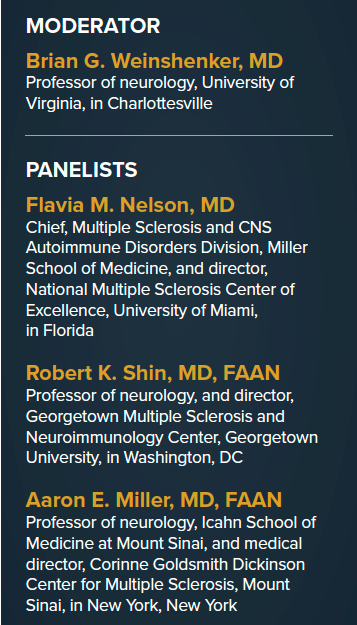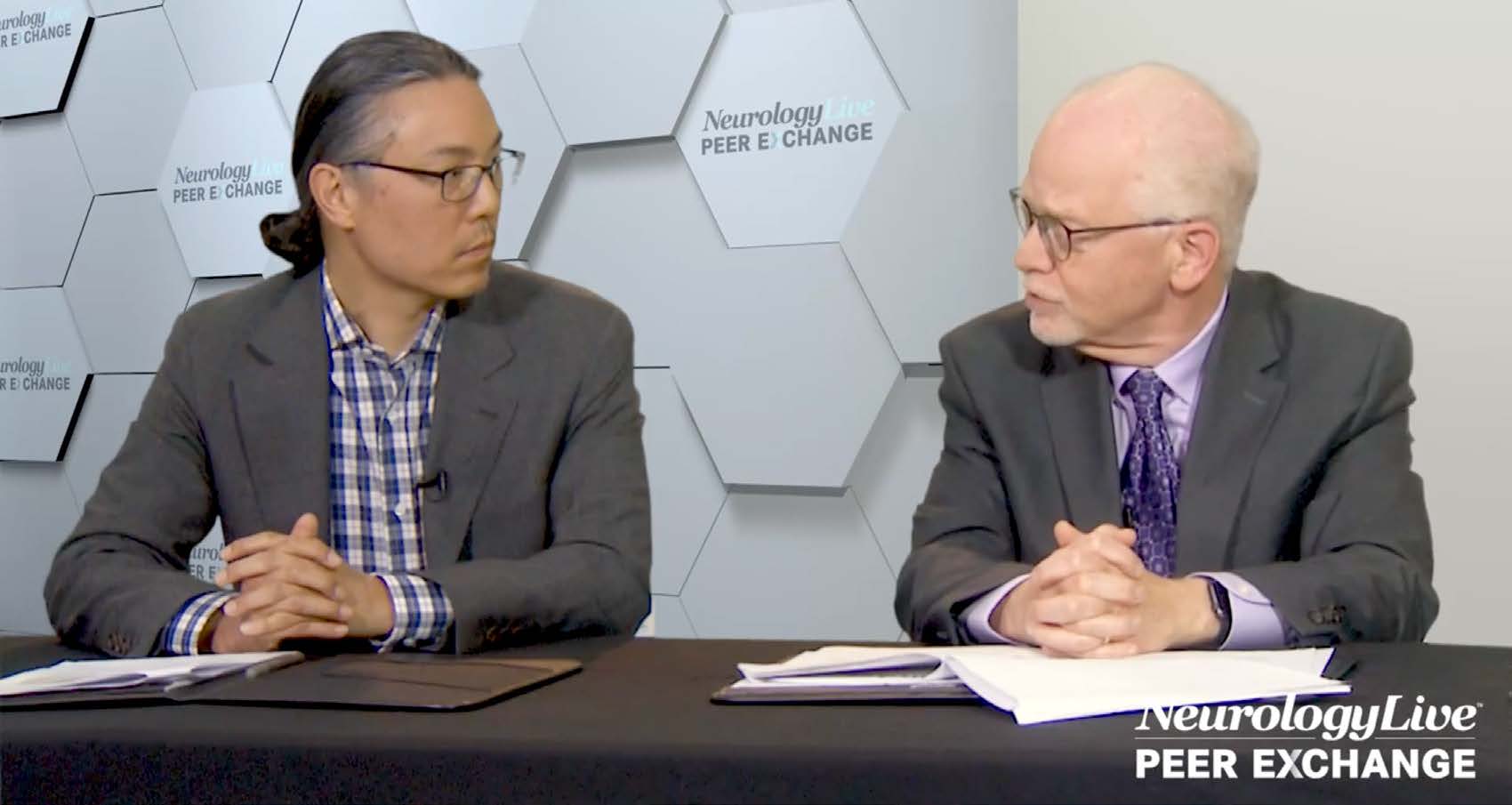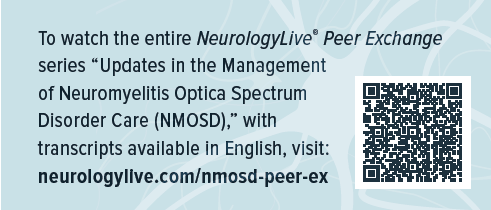News
Article
NeurologyLive
Key Updates in the Management of Neuromyelitis Optica Spectrum Disorder
Author(s):
A panel of experts in the treatment of patients with NMOSD discusses and offers insight into the vital aspects of diagnosis, disease management, and therapeutic strategy.
Participating in the panel are, from left, Robert K. Shin, MD, FAAN; Brian G. Weinshenker, MD; Flavia M. Nelson, MD; Aaron E. Miller, MD FAAN.


MERELY 5 YEARS AGO, the treatment landscape for neuromyelitis optica spectrum disorder (NMOSD) was sparse, with physicians limited to off-label therapies. Stepping back 5 years further, the limitations grow larger, with no targeted options and only a fledgling database of research guiding those treating patients with NMOSD.
Much of this changed on the back of research into aquaporin-4 (AQP4), a water channel protein discovered in the late 1980s and linked to NMOSD in the mid-2000s1,2 that has come to serve as the key biomarker of the disease. A little more than a decade after AQP4 was associated with NMOSD came the June 2019 approval of eculizumab (Soliris; Alexion) and, 1 year after that, the approvals of inebilizumab-cdon (Uplizna; Horizon Therapeutics plc) and satralizumab-mwge (Enspryng; Genentech).3-5 With these 3 therapies alone, the clinical care paradigm has rapidly shifted toward the positive, and now a possible fourth option, ravulizumab-cwvz (Ultomiris; AstraZeneca), is before the FDA with an application for an NMOSD indication.
In light of this changing backdrop to clinical care in NMOSD, NeurologyLive® brought together a panel of experts from institutions around the United States to discuss the optimal approach to treating patients. The panel was moderated by Brian G. Weinshenker, MD, a professor of neurology at the University of Virginia in Charlottesville, and a member of the team whose work identified the role of AQP4 in NMOSD.2 Throughout the extended conversation, Weinshenker guided the panelists through the most important facets of the management of this disease, how care has changed with these novel options, and much more.
Initiating Treatment and Goals of Therapy
If patients with NMOSD are left untreated, they face irreversible damage and disability from the effects of the disease, including paralysis, with many individuals going completely blind in a matter of years.6 Although, with some choice in therapeutic avenues now available, establishing the goals of treatment with patients is a clear first step toward improving their prognosis.
Flavia M. Nelson, MD, chief of the Multiple Sclerosis and CNS Autoimmune Disorders Division and director of the National Multiple Sclerosis Center of Excellence at the University of Miami Miller School of Medicine in Florida, explained to the group that for each of the disease-modifying therapies (DMTs), the baseline goal is to decrease inflammatory response. In turn, this reduces the formation of lesions in the central nervous system and the number of relapses that patients experience, she said. However, these goals may change slightly based on the stage of disease; a patient experiencing an acute attack would be approached differently from one with less active disease.
“There are 2 different types of treatment,” Nelson said. “One is to prevent the disease from progressing and [the other] is to treat the relapses. For an acute attack, we need to intervene with high-dose steroids or plasma exchange to reduce the inflammatory response and prevent irreversible tissue damage, then we can use the long-term treatments to prevent the immune response from causing more lesions and attacks.”
Although the general prevention of problems, as Weinshenker put it, is the preferred route of management for patients, the timing of this care is just as important, as is the need for long-term perspective. For panelist Aaron E. Miller, MD, FAAN, following diagnosis, the long-term care plan should be established instantaneously.
“I start to consider [a care plan] as soon as I have the inkling that this is NMOSD,” said Miller, who is a professor of neurology at the Icahn School of Medicine at Mount Sinai, and the medical director of the Corinne Goldsmith Dickinson Center for Multiple Sclerosis at Mount Sinai, in New York, New York. “I’m going to start thinking about it right away, because this is a disease where the attacks can be devastating. And they’re unpredictable; they can come at any time, so, you want to get a person on an effective [DMT] as quickly as possible.”
Miller noted that for much of his multidecade career, the field lacked the aforementioned proven therapies, with most patients being treated with a variety of broad-spectrum immunosuppressive medications, such as azathioprine or mycophenolate. “With the recognition that this was a disease driven by a specific antibody, we started to use rituximab, a B cell–depleting agent. [However], the real revolution came about 2 years ago. I can remember hearing at the same meeting presentations about several different agents, and I went back to my hotel room and started practicing—can I say, ‘eculizumab, inebilizumab, [and] satralizumab?’ Almost simultaneously, the availability of 3 very effective agents has really revolutionized the thinking about how to treat NMOSD,” he said.
Aaron E. Miller, MD, speaks about maintaining a long-term perspective on care, as Flavia M. Nelson, MD, listens on.

When deciding on the goals for therapy, as is often the case, severity of disease and the information that can be collected with various clinical tools is essential. Nelson noted that she considers the number of lesions a patient has and the extent of those lesions on MRI, in addition to other factors, such as access to specific therapies.
Robert K. Shin, MD, FAAN, a professor of neurology and director of the Georgetown Multiple Sclerosis and Neuroimmunology Center at Georgetown University, in Washington, DC, said his first goal in care is the prevention of relapses—a goal that can be achieved with any of the approved options. “In my mind, they differ in terms of how they’re administered and how frequently they might need to be taken from a tolerability standpoint. In my decision-making, I feel lucky to have multiple effective options to choose from. We spend most of our time talking about, in some sense, the logistics of how each one is given,” Shin said.
Approved DMTs vs Other Treatments
As Shin explained, each of the available treatments offers its own mechanism of action, route of administration, and dosing schedule. Eculizumab is administered via intravenous injection every 2 weeks after an initial titration period,7 satralizumab is administered via subcutaneous injection every 4 weeks afteran initial titration period,8 and inebilizumab is administered via intravenous infusion every 6 months after dilution and a titration period.9 As such, each choice offers patients some variety.
Weinshenker pointed to this choice as an important discussion topic, particularly for those who have already been treated (successfully or not), with existing off-label options that might have different targets, and when physicians are faced with considerations about the presence of polymorphisms. As Nelson alluded to, access can play a major role in these decisions, even if it is still too early to say how much that will affect care, Weinshenker said.
“We are now using these [new] treatments for newly diagnosed cases,” Nelson said. “There are a lot of patients [who] are already on rituximab and doing well. We’re only going to go to these next-level drugs if they fail.”
“Unfortunately, we really don’t have data as far as which drug is superior. Often, it comes down to cost and convenience issues,” Weinshenker said. “There’s at least some theoretical reason to think that inebilizumab may be superior to rituximab, but we don’t have great evidence to support that. There were some data on patients who were in the inebilizumab trial who had previously been on rituximab, and when they looked at the approximately 7 patients [whom] that that applied to, they were all free from attacks on inebilizumab. The assumption that they failed 1 B-cell depleter means they weren’t going to do well, and that doesn’t seem to be borne out.”
For Weinshenker, the challenge of access is sometimes the great decider, although even an official indication from the FDA might not lend a hand in that instance. “With rituximab, even though we had difficulty getting it approved by the patient’s insurance sometimes, we’ll hear now that until a patient has failed rituximab, they can’t be considered for one of the newer agents,” he said. Shin echoed this experience, noting that in the past, he would have to justify the off-label use of rituximab, but now he’s been challenged to use one of the approved options in place of rituximab. “In a way, we’ve had to fight that battle on both ends,” Shin said.
“Even 1 relapse can be devastating,” Shin said. “Even at the beginning, if I have the option, I have tried to rely on FDA-approved agents with clinical trial data that has demonstrated high efficacy in some sense, so I can feel that I’ve done the most I can do to prevent that possibly devastating relapse.”
Miller chimed in to say that even in lieu of sufficient evidence to prove that the newer agents are more effective even than rituximab, physicians should be willing to take on the battle, particularly for their newly diagnosed, treatment-naïve patients. These individuals stand to benefit the most from immediate and effective treatment, and the FDA-approved therapies all certainly offer that, he said. “We can make substantial arguments. I’m not sure we’ll always be successful, [but] it’s worth engaging. [However], I’m not so sure we should be switching a patient who’s been doing well for years on rituximab to one of the newer agents,” Miller said.
Another important distinction, Nelson said, is that patients need to be AQP4 antibody positive to be approved for these new options, which is a key detail of the therapies’ labels. Not every patient with NMOSD is AQP4 seropositive, and in those cases, physicians are still somewhat limited in what choices they have.
Brian G. Weinshenker, MD, inquires with Robert K. Shin, MD, FAAN, about the new disease-modifying therapies for neuromyelitis optica spectrum disorder.

Practice Pearls for NMOSD Management
Before the discussion closed, the group pointed to several applicable clinical care tips that physicians who encounter NMOSD could use. For Miller, this served as a chance to reiterate the immediacy of care and the importance of a proper diagnostic work-up. He noted that at face value, physicians should ensure they are at least considering a diagnosis of NMOSD when appropriate.
“We should have a low threshold for testing the antibody status in a patient who’s presenting with an inflammatory demyelinating syndrome. There are many ophthalmologists already who are screening every patient with optic neuritis, even those who don’t typically look like they’re going to be NMOSD, for antibodies,” Miller said. “But along with the screening, it’s really important to emphasize [that] you [must] know the laboratory that’s doing your testing. You need to do a cell-based assay for the anti-AQP4 antibody. Some of the large commercial laboratories are still doing [enzyme-linked immunosorbent assays], and that’s not an adequate test.”
Nelson confirmed Miller’s note, adding that one of the bigger sticking points is from the imaging perspective in diagnosis. She explained that when an MRI is done, if there are few lesions in the brain but there are lesions in the spinal cord, NMOSD should still be considered, especially if the patient is negative for AQP4 antibodies. “Remember that it doesn’t have to be large lesions in the spinal cord. You can have NMOSD with small lesions. So again,think of the diagnosis and don’t miss it, because you need to treat it properly,” she said.
Shin reinforced proper diagnosis again, adding that antibody testing should be done for any of individual who presents with optic neuritis, a form of transverse myelitis, or an area postrema syndrome. Importantly, this testing should not only account for AQP4 but also for myelin oligodendrocyte glycoprotein.
“I would even expand this to maybe our own population of patients who [have] multiple sclerosis,” Shin said. “I don’t think it’s appropriate for every person, but [maybe] someone with an atypical case, as Nelson mentioned, the MRI doesn’t quite look MS typical, and perhaps they haven’t responded to our attempts to treat their MS, or perhaps they worsened because we really have to test for the AQP4 antibody cell-based assay.”

Weinshenker agreed, adding that it is crucial for physicians to remember that NMOSD can present in unusual ways. He recalled a patient with encephalopathy who had a very large butterfly lesion in the splenium of their corpus callosum. “That would certainly not have been a patient who one would’ve thought of as having NMOSD, but this patient was seropositive. It’s just being aware of these various presentations. Hydrocephalus can rarely occur because of the inflammation, so in a patient who might have a history of optic neuritis and then develops hydrocephalus, that would be suggestive of neuromyelitis optica,” he said.
REFERENCES
1.Benga G, Popescu O, Pop VI, Holmes RP. p-(Chloromercuri)benzenesulfonate binding by membrane proteins and the inhibition of water transport in human erythrocytes. Biochemistry. 1986;25(7):1535-1538. doi:10.1021/bi00355a011
2. Lennon VA, Wingerchuk DM, Kryzer TJ, et al. A serum autoantibody marker of neuromyelitis optica: distinction from multiple sclerosis. Lancet. 2004;364(9451):2106-2112. doi:10.1016/S0140-6736(04)17551-X
3. Alexion receives FDA approval of Soliris (eculizumab) for the treatment of adults with neuromyelitis optica spectrum disorder (NMOSD) who are anti-aquaporin-4 (AQP4) antibody positive. News release. Alexion. June 27, 2019. Accessed May 5, 2023. https://news.alexion.com/press-release/product-news/alexion-receives-fda-approval-soliris-eculizumab-treatment-adults-neuromy
4. FDA approves new therapy for rare disease affecting optic nerve, spinal cord. News release. FDA. June 11, 2020. Accessed May 5, 2023. https://www.fda.gov/news-events/press-announcements/fda-approves-new-therapy-rare-disease-affecting-optic-nerve-spinal-cord
5. FDA approves Genentech’s Enspryng for neuromyelitis optica spectrum disorder. News release. Genentech. August 15, 2020. Accessed May 5,2023. https://www.businesswire.com/news/home/20200814005501/en/ADDING-MULTIMEDIA%C2%A0FDA-Approves-Genentech%E2%80%99s-Enspryng-Neuromyelitis-Optica
6. Wingerchuk DM, Lennon VA, Pittock SJ, Lucchinetti CF, Weinshenker BG. Revised diagnostic criteria for neuromyelitis optica. Neurology. 2006;66(10):1485-1489. doi:10.1212/01.wnl.0000216139.44259.74
7.Soliris. Prescribing information. Alexion Pharmaceuticals Inc; 2019. Accessed May 10, 2023.https://www.accessdata.fda.gov/drugsatfda_docs/label/2019/125166s431lbl.pdf
8.Enspryng. Prescribing information. Genentech; 2020. Accessed May 10, 2023. https://www.accessdata.fda.gov/drugsatfda_docs/label/2020/761149s000lbl.pdf
9. Uplizna. Prescribing information. Horizon Therapeutics plc; 2020. Accessed May 10, 2023.https://www.accessdata.fda.gov/drugsatfda_docs/label/2020/761142s000lbl.pdf




